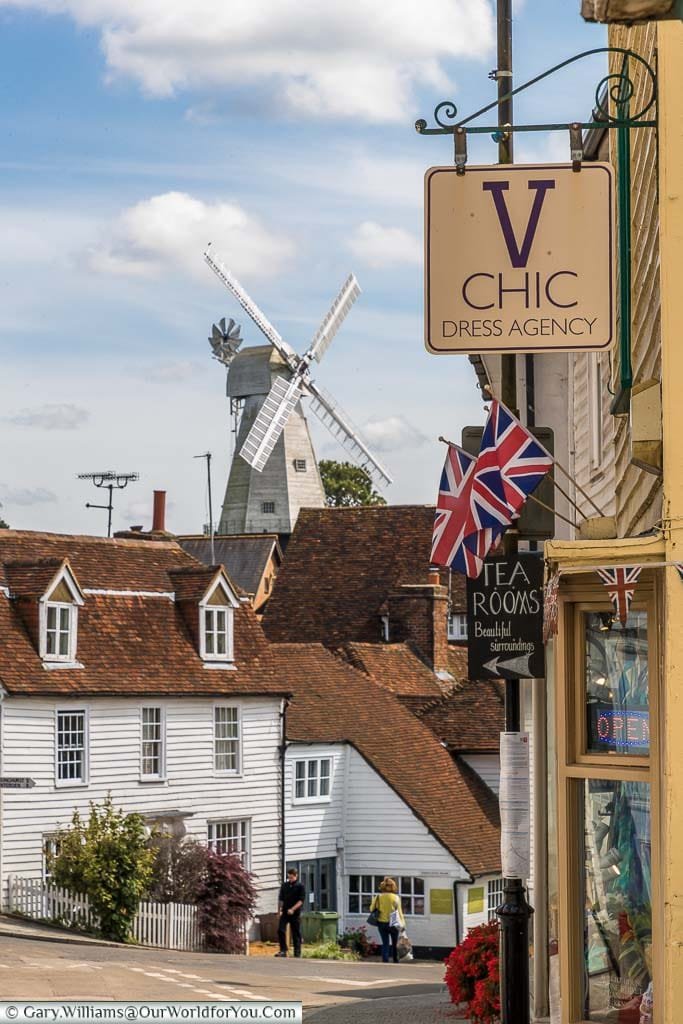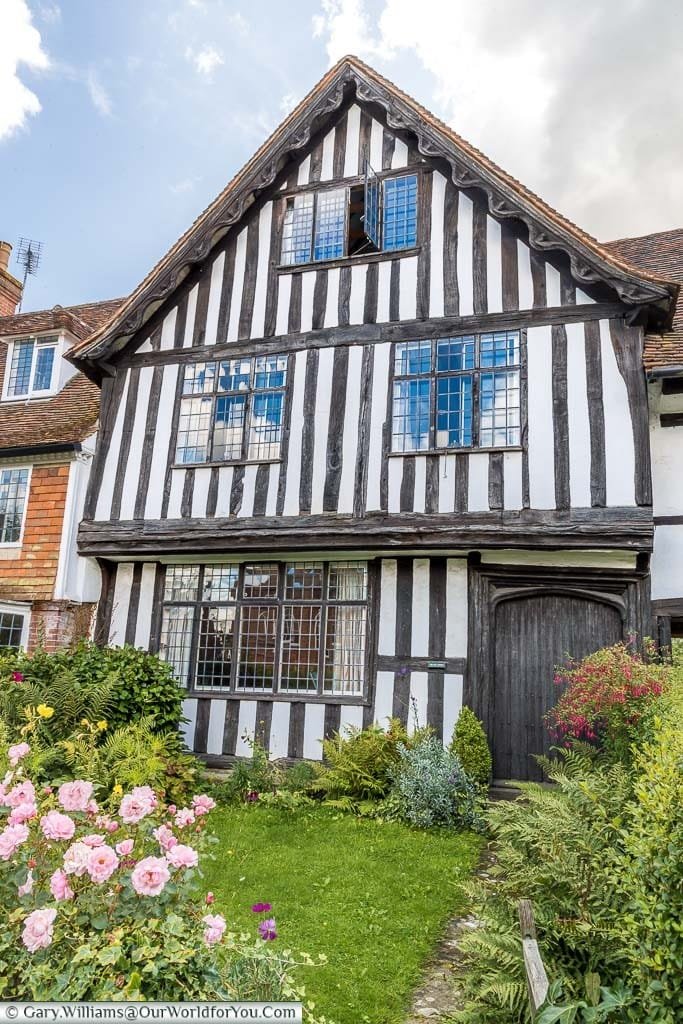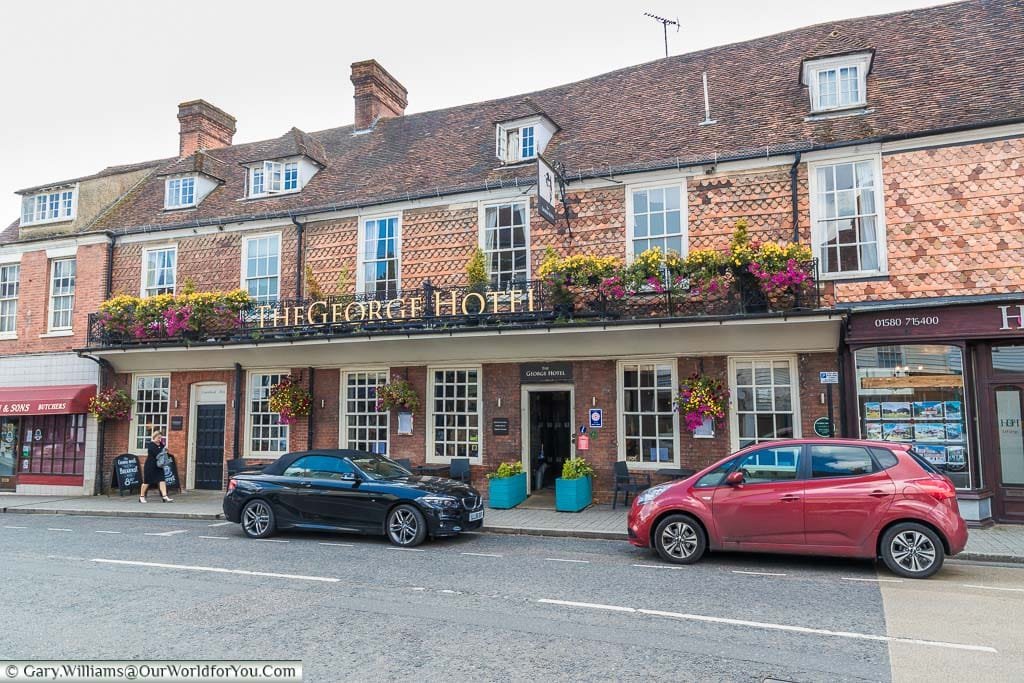From Kent’s oasts to Kent’s coast
We’re back exploring a further 8 of Kent’s delightful towns and villages. There are so many picturesque places to choose from in Kent, from its remote countryside villages to its historic ancient towns.
We find the perfect way to visit these quaint villages is on a road trip, as often, these locales are off the main routes. And with more and more EV charging stations popping up across Kent, you can easily tour the county in your electric vehicle.
Hopefully, you caught my first post, ‘8 picturesque villages and towns in Kent – Part 1’. We chose some real gems like Lenham, Smarden, Upnor, Faversham, Hythe and Headcorn.
So, let’s start unearthing an additional 8 beautiful locations in Kent and discover the quirky tales behind them.

The friendly village of Charing is a must to explore as it has fascinating historical connections with Royalty and archbishops. For such a small Kent village, it certainly packs a punch.
Charing is located just a short hop off the A20, and if you don’t make the tiny detour, you’ll miss it.
Charing is nestled at the foot of the Kent Downs, an Area of Outstanding National Beauty (AONB) and sited along the Pilgrims Way. This historic route was used by pilgrims journeying from London to Canterbury Cathedral.

Now let’s tell you about the ancient Archbishop’s Palace. The ruins of Charing’s Archbishop’s Palace date from the 13th-century and are adjacent to the Church of St Peter and St Paul. In its heyday, the palace was visited by several Royals, including Henry VII and Henry VIII.
The monarchs stayed on several occasions, and the palace became the property of the Crown during the Dissolution of the Monasteries in 1545.

Although the local pub has now closed, you’ll find a welcoming micropub named the Bookmakers Arms. Also, in Charing, there’s a fantastic family butcher and a village store.
We visited Charing as part of our road trip around the Kent Downs (AONB); you’ll discover some gorgeous locations with this Kent road trip itinerary.
Where to stay near Charing
The Dog and Bear Hotel
Stay informed
We’re now heading to the attractive market town of Cranbrook, the ‘Capital of the Weald’.
One thing that makes Cranbrook in Kent so special, and why it has kept its charming qualities, is that non-visiting traffic is diverted away. You’ll only discover Cranbrook if you follow the signs to the historic town centre.


Cranbrook in the heart of the ‘High Weald’ is like stepping back in time. The eye-catching black and white half-timbered homes and inns are stunning.
This region of Kent is known as the ‘Weald of Kent’ and has some intriguing history, during the 14th century, Edward III introduced Flemish weavers to the area. The Wealden cloth industry then began to flourish, and that’s why so many eye-catching half-timbered ‘Cloth Halls’ are dotted around the county.

Amongst the many interesting aspects of Cranbrook is St Dunstan’s Church, locally known as the ‘Cathedral of the Weald’. Although it isn’t actually a cathedral, it echoes the prosperity of the historic town.
A curious and quirky fact about St. Dunstan’s Church is the clock tower. The clock’s inner mechanism was installed in 1855 and was the prototype for ‘Big Ben’ in London.
We visited the captivating town of Cranbrook during our ‘Road trip around the Kent Countryside’.
Where to stay in Cranbrook
Tempted to?
Cobham is a delightful little village with plenty of history. When visiting Cobham, you’d think you were deep in the Kent countryside; however, the attractive village is only 1 mile from the A2.
The main street in Cobham is a pleasure to stroll through. At one end of the village, you can visit Owletts, the National Trust managed home of British architect Sir Herbert Baker. Then meandering on, you pass by the 13th-century St Mary Magdalene Church; through Cobham, there are beautifully kept houses, flint cottages and a weatherboarded village store.

Nearby locals play crown green bowls; the cricket club’s whites are freshly pressed for the summer season, and friends share a tale or two over the garden fence.
It’s not surprising that Charles Dickens visited Cobham in Kent regularly. Mr Dickens would often head to the timber-framed alehouse, The Leather Bottle, where he was known to have stayed in rooms 2 and 6. The Leather Bottle Inn features in the novel by Charles Dickens, The Pickwick Papers.

At the opposite end of Cobham, passing by the village war memorial is Cobham Wood and the Darnley Mausoleum, also managed by the National Trust.
If you’re visiting Cobham, why not embark on one of our Kent road trips. Our Scenic Medway Valley road trip takes you to Aylesford, Upnor, and Rochester, with a little detour to Historic Dockyard Chatham.
Where to stay in Cobham
If you're intrigued by Kent's weird and wonderful history, or all unusual stories around the county, then take a peek at "Kent's Strangest Tales".
You won't be able to put it down, you can pick it up for your Kindle or in good old paperback.
I love visiting Deal; it’s like stepping back in time and a perfect place to enjoy fish and chips from paper wrapping. There are plenty of seats along the far-reaching promenade, so take a pew and sit back and enjoy the view.
Deal is ideal for a day trip; however, it’s even better for a mini break, as you’ll have time to try one of Deal’s many delicious restaurants. It’ll also allow you to explore more in the county of Kent.


You’ll discover so many delights in Deal, from the working fishing boats along the pebbly shore to ambling through the quaint lanes admiring the pastel-coloured fishermen’s cottages.
All through the town are quirky independent shops, tempting inns, and some fascinating history, especially its connection with the Cinque Ports.

I can’t wait to head back to Deal again; we’re certainly due for another visit.
You can visit Deal as part of our Scenic coastal road trip around the shores of Kent, including many stops along the way, including Margate, Sandwich, Folkestone, and Dungeness,to name a few.
Where to stay in Deal
We have a new little book on our shelves that we delve into when we're heading to the coast.
Packed full of historical facts, and broken down into the different counties of England. It tells tales of the history of the shoreline that surrounds our country.
Available in Kindle & Hardback editions, it's an excellent addition to anyone's collection who loves the English seaside.
Wrotham is a pleasure to explore; we’d driven around its outskirts numerous times but never really headed into the heart of the historic village. When visiting Wrotham, you feel like you’re in such a remote part of Kent, and in truth, you are only ½ a mile from the M20.
There are so many deliciously quaint homes in Wrotham. Beautifully kept gardens with rambling roses climbing over charming cottages and characterful architecture lining the pretty High Street.

Ensure you take a mooch all-around Wrotham; it’s delightful. Stroll up through the village square passing by the eye-catching village sign. Wander up past the Old School House to the 13th-century St George’s Church, which sits proudly overlooking Wrotham. Unusually a large section of the old churchyard is north of the village.
The ancient traveller route, the ‘Pilgrims Way’, which begins in London, passes through Wrotham on its way to Canterbury Cathedral.
Now I know you will try not to get distracted by Wrotham’s three pubs, but incredibly there used to be four until 2009. It’s great to see a local village pub still going, the Rose and Crown, the George and Dragon and the Bull Hotel. The BBQ menu in the Bull Hotel is outstanding.
Once you’ve explored Wrotham, why not continue following our circular road trip from Wrotham in Kent. You can also visit the charming market town of West Malling.
Where to stay in Wrotham

Strolling around Westerham is such a pleasure as there is striking historical architecture to admire around nearly every corner. We particularly loved it by The Green, a lovely open space to sit and relax, lined with quirky shops, tearooms, and the Grasshopper on the Green Inn.
Westerham is full of intriguing connections with the past and with two of its prior notable residents. Firstly, Sir Winston Churchill, who lived nearby at his family home of Chartwell House and secondly, General James Wolfe, who resided at Quebec House as a child. Both of these historic residences are managed by the National Trust.

Westerham was mentioned in the Domesday Book of 1086; however, it can trace its heritage back thousands of years to the Celts and the Romans.
As you amble around Westerham, ensure you stroll around the bustling Market Square. It has a lovely feel around here, with locals dining al-fresco and a striking array of Georgian architecture.
We visited Westerham as part of our Historic Kent road trip in and around Westerham. This also included a visit to Churchill’s home of Chartwell and Hever Castle.
Where to stay in Westerham

Rolvenden is like a blast from the past, with its old-style garage and petrol station, with just one pump, which I’m sure wasn’t self-service. A welcoming village store, a lonesome disused red telephone box and a charming village green, what more could you want?
Oh yes, a couple of antique shops and of course, a motor museum with a handsome collection of Morgan cars.

The Romney Marsh region of Kent is one of my favourite places to visit in the county. It is so unique and distinct from any other parts of Kent and often referred to as the ‘Fifth Continent’
The history around this southern part of Kent fascinates me, especially given that some of the surrounding inland towns and villages were once bustling harbours. Incredibly New Romney was one of these locations and in its maritime heyday, was one of the Crown’s Cinque Ports.

Today New Romney is now over a mile from the sea due to a severe storm in 1287 that silted up New Romney harbour and surrounding areas of the Kent shoreline. Kent's coastline was re-mapped forever.
Visiting the medieval Norman church of St Nicholas in New Romney, you’ll notice its West Door considerably lower than street level. This is due to the mud, silt and sand deposited in the town by the Great Storm.

New Romney truly has its own character wandering along Dymchurch Road, the main High St. The quaint little town is full of independent stores, cafés, and restaurants. You’ll also find a few familiar shop names; you can’t keep everyone out.
Strolling around the charismatic streets of New Romney, you’ll discover some intriguing architecture; head to West Street to find a row of charming historic cottages.
We visited New Romney as part of our Romney Marsh road trip. Which also included a visit to Hythe, Dymchurch, Lydd and Dungeness.
Where to stay in New Romney
Escape for a few days
Are you looking for that ‘perfick’ holiday hideaway to relax in while you discover the Garden of England?
After a day exploring the Kent coast and its many historic castles enjoy one of the handpicked properties and unique retreats at Holiday Cottages.
* This post may contain links to affiliated sites where we earn a small commission at no additional charge to you.


